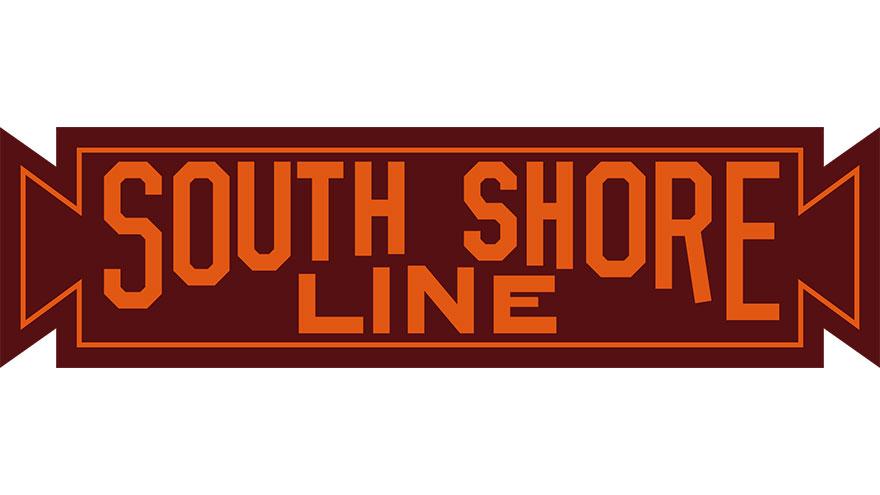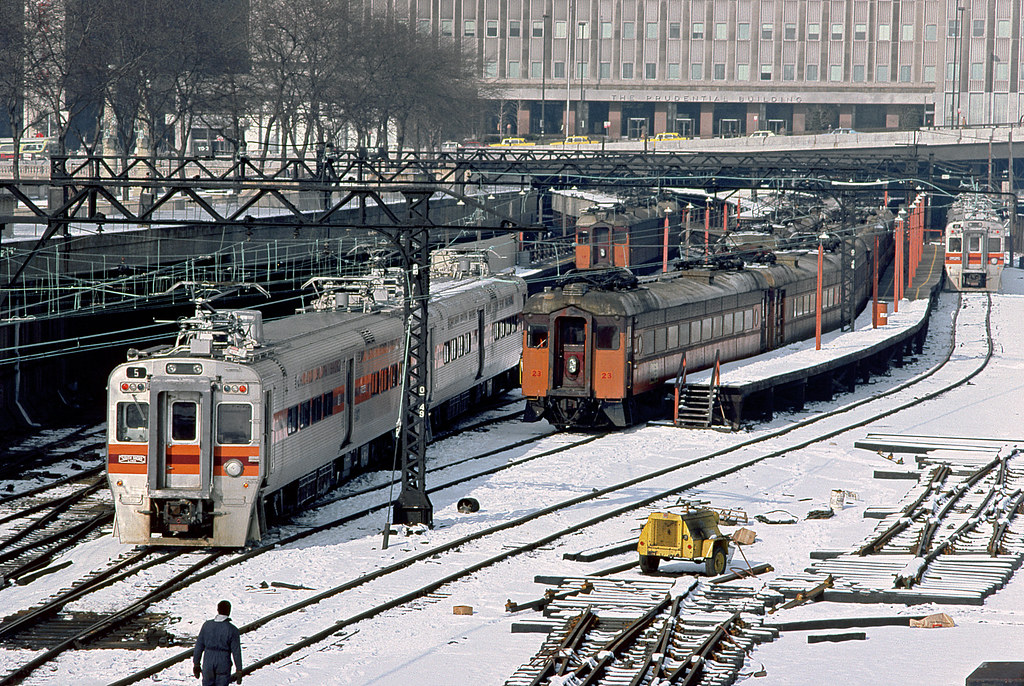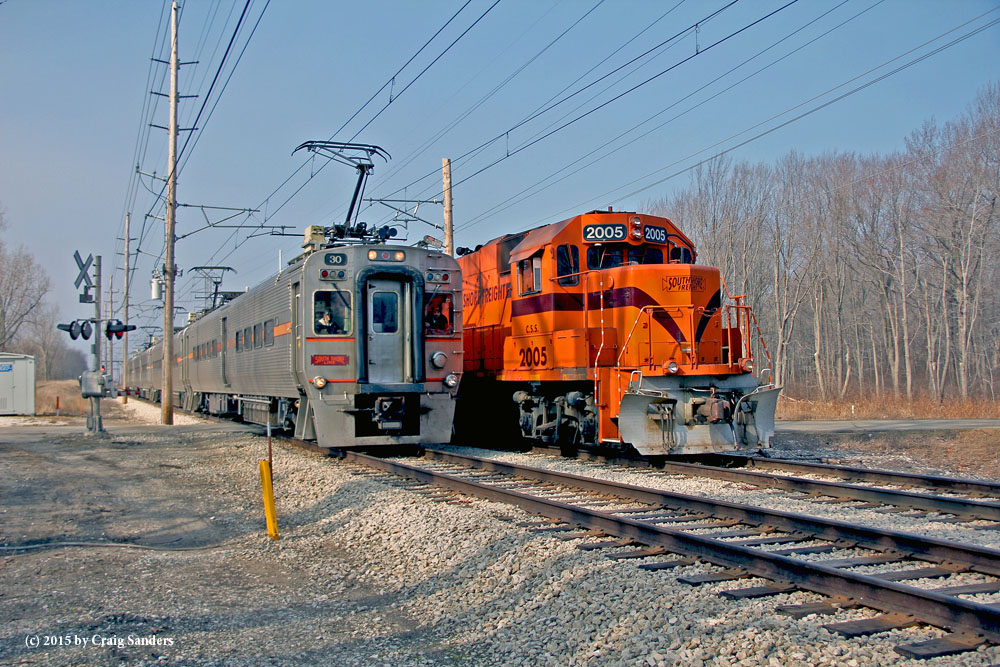Welcome to another new month of Twice-Weekly Trolley History here on Blogger! I know your eyes are probably hurting from last month's deluge of information, but I can assure you we're back to our normal length once again. You may remember from last month, as well, that we covered the old South Shore Line as part of our review of Chicago interurbans and street railways. Today, we're going to continue that story and look at what happened to one of Samuel Insull's "First and Fastest" railways that is now the "Last and Longest". It's America's only true remaining interurban, and it's only on Trolley Tuesday!
-----
 |
| The current South Shore logo, as used by the NICTD. (NICTD) |
 |
| A late 1970s graphic South Shore put on their aging Pullman fleet, as well as their 800-series freight locomotives. (John Bell) |
 |
| NICTD logo in South Shore colors. (NICTD) |
 |
| One of the last electric freight operation of the old South Shore, as 803 moves a caboose and a couple freight cars out of Burnham Yard. (Sam Carlson) |
The Northern Indiana Commuter Transportation District (NICTD) was formed in 1977 as a governing body to subsidize the still-private South Shore Line. Nothing much change between 1977 and 1981, as both the old Samuel Insull-era 1926 Pullman cars continued to see modest passenger service, while the big electric freights soldiered on under the C&O's management. Due to ICC regulations that forbade state or national companies from handling both freight and passenger trains (later killing Amtrak's brief period of large-scale package deliveries), the NICTD only subsidized the passenger operations. The freight sector died off on January 31, 1981, when the last electric freight train was hauled by "800" class No. 803.
 |
| The new Nippon Sharyos take over for the old Pullmans on a cold January 17, 1983, at Randolph Street Station. (Now Millenium Park, Chuck Zeiler) |
The following year, the NICTD declared they would invest heavily in new rolling stock from Japanese manufacturer Nippon Sharyo. In 1982, the old Pullmans were retired with most going to museums like the East Troy and Illinois Railway Museum, and in their place were new Nippon-Sharyo single level electric multiple units (EMU's). The large order of 68 married pair cars were 85 feet long (per car) with a top speed of 79 miles per hour, making them longer and faster than the original Pullmans, and shared some of their construction with the Maryland Rail Commuter (MARC) service's MARC-II passenger cars. In further contrast, the new EMU's were delivered in a shiny, almost futuristic fluted stainless-steel car body, with orange stripes along the windows and below the front windows maintaining that familiar South Shore identity.
 |
| A South Shore GP38-2, No. 2005, passes one of the Sharyos at Lake Shore County Road, Michigan City, IN, 2015. (Akron RR Club) |
This large order of cars did not come cheap, as by 1989, the legal business entity known as the Chicago, South Shore & South Bend Railway went bankrupt. NICTD assumed passenger service on December 29, 1989, and a year later the tracks were sold to the state authority. The freight operations, long since dieselized, were passed on to the Anacostia & Pacific (now Anacostia Rail Holdings). With the NICTD now no longer just a governing body, they began rebuilding what was left of the South Shore, starting with the line's South Bend terminus moving from the local Amtrak station to South Bend Airport (which was seeing higher passenger numbers). The new station was originally built on a old freight spur, but extensions directly into South Bend Airport meant that when it opened on November 20, 1992, it made for a convenient commute by air or by rail.
 |
| South Shore Line's South Bend Airport terminal, with an outbound train west for Chicago. (David Wilson) |
| Hudson Lake, one of three remaining flag stops on on the South Shore, which really is just a bus shelter and a concrete sidewalk platform. |
Further closures also occurred, with the heaviest station closures occuring on July 5, 1994. These were all flagstop stations, meaning trains would only stop if someone requested it on the platform. These local stops would often clog service schedules, so NICTD dropped the flag stops (seven of them) and folded them into the closest big station under their new service revisions. Many of the stations like Ambridge, Rolling Prairie, and New Carlisle, were opened in the early 1900s, while the most recent station to close was Kemil Road (which opened in 1977 under the South Shore Recreation (SSR) citizens group). The latter was one of the more contentious stops, as local resident and SSR founder Lois Weisberg was able to get the South Shore to pay for the stop (a cost of $700, which, for a struggling railroad, is a lot) on the condition she stop publicly criticizing the railroad and its then-president, Albert Dudley.
| An evening view of the Beverly Shores flag stop, another of the three active flag stops left on the South Shore. (Jonathan Lee) |
 |
| South Shore's Millenium Station subway, platform 8. (Jacob G.) |
The northern end of the line still remained the Illinois Central Randolph Street Station, though it was now named the Millenium Station due to being under Millennium Park. NICTD's fare zones were based around the proximity to the station with 11 fare zones from Millennium Station to South Bend, a total distance of 90 miles and across two time zones (Central and Eastern). Two fare zones within Chicago were not covered, as the larger Metra organization already laid claim to those. From Millennium Station to Kensington/115th street, the line is quadruple tracked as the Metra Electric (originally Illinois Central) shares track with the South Shore. Under a long-standing non-compete clause, NICTD trains only loads passengers outbound from Millenium Station and only unloads passengers when inbound to dissuade local commuting in Chicago. Aside from a double-track section between Kensington and Gary, the rest of the line is single-tracked all the way to South Bend Airport, with passing sidings provided.
 |
| The Highliner II's make their way down 11th Street in Michigan City, Indiana, 2010. (Mickey B.) |
By the turn of the 21st century, the South Shore was still going strong on their little Chicago-South Bend corridor. Due to increasing ridership, the railroad invested in new "Highliner II" bi-level EMU's from Nippon Sharyo, with these patterned after Metra's own bi-level coaches from the same manufacturer. With increased ridership, however, came some operational problems like the line through Michigan City, Indiana. Historically, trains in Michigan City shared the street with auto traffic, but the larger rolling stock and faster service meant this part of the line became a bottleneck. By July 2009, the NICTD announced it would relocate its track just south of the current alignment and consolidate the 11th Street stops with a new high-level platform. After a few financial setbacks, the project is now on track to coincide with the new double-tracking between Gary and Michigan City.
 |
| The current South Shore Line map, with Metra Electric branch services displayed. (NICTD) |
 |
| A South Shore Line service arriving at Indiana Dunes station, 2007. (Chris Light) |
The other possible expansions to the system today are the Valparaiso Branch and the West Lake Corridor. The former planned to use an old Pennsylvania Railroad Line to connect the current line at Gary, IN, with Valparaiso to the southeast (just directly south of Indiana Dunes National Park). The original plan was to run to Munster (south of Hammond and Calumet City), but using an existing alignment was more economically viable. Unfortunately, this project was mothballed in favor of the West Lake Corridor, which involved moving the existing Hammond station to become Hammond Gateway, and running a branch over the Calumet Rivers (Grand and Little) south to Munster. At the cost of $665 billion, the railroad is hopeful it can open the new line by 2025. As for the Valparaiso Branch, the Indiana Dunes station received an upgrade to high-level platforms and a bus connection to Valparaiso instead, thus avoiding service redundancies with the heavy rail commuters.
| South Shore Railroad (CSS) GP38-2s 2007 and 2004 rescue train 503, after it snagged and tore the catenary in Ogden Dunes. The train is being towed to the Shops. (Jonathan Lee) |
So what more can be said about the last interurban? Though its glory days are long since behind them, the new South Shore continues to uphold the legacy of service and swiftness delivered by their predecessor, and the NICTD never resists a chance to pay tribute to their ancestry. The freight sector is now a Class III freight railroad hauling coal and steel between Michigan City and Burns Harbor, but is otherwise still completely separate. So if you are ever in the Chicago Area and feel like taking a ride on ongoing history, take a ride on the South Shore and enjoy the Last and Longest Interurban in the United States.
 |
| The cover of the Shore Line Interurban Historical Society's Dispatch No. 3, featuring a poster celebrating the South Shore's 100th anniversary in 2008. (Shore Line Interurban Historical Society) |
-----
Watch your step as you alight onto the platform and thank you for reading with us! Next week, dip back into history by looking at the many railways that made up the short-lived Indiana Railroad Interurban! Until then you can follow myself or my editor on twitter if you wanna support us, and maybe buy a shirt as well! Ride safely, now!
No comments:
Post a Comment